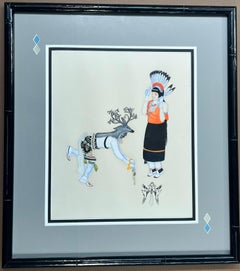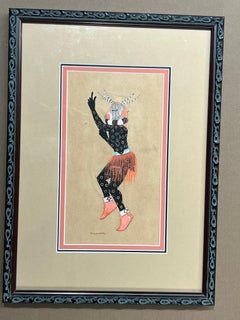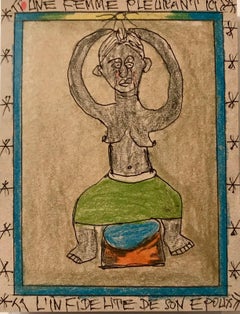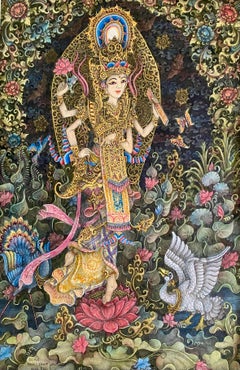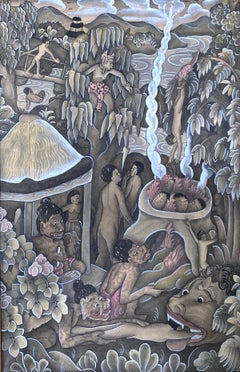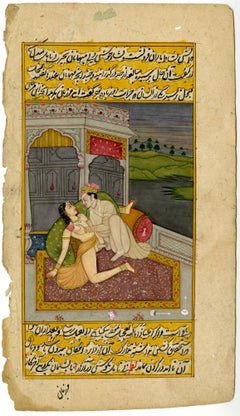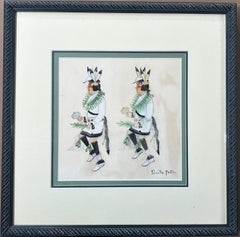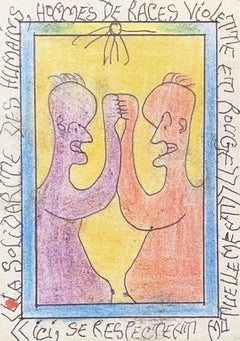Tribal Drawings and Watercolor Paintings
to
2
4
4
2
6
5
1
Overall Height
to
Overall Width
to
7,257
6,495
5,392
2,148
618
544
510
456
373
329
226
220
74
73
6
4
3
3
2
2
2
2
1
1
1
1
1
4
2
2
1
1
4
4
3
2
2
Style: Tribal
Deer Dance, painting by Tonita Pena, Santa Fe, Cochiti, Pueblo, male, female
Located in Santa Fe, NM
Deer Dance, painting by Tonita Pena, Santa Fe, Cochiti, Pueblo, male, female
Tonita Peña (born 1893 in San Ildefonso, died 1949 in Kewa Pueblo, New Mexico) was born as Quah Ah (meaning white coral beads) but also used the name Tonita Vigil Peña and María Antonia Tonita Peña. Peña was a renowned Pueblo artist, specializing in pen and ink on paper embellished with watercolor. She was a well-known and influential Native American artist and art teacher of the early 1920s and 1930s.
Tonita Peña was born on May 10, 1893, at San Ildefonso Pueblo, to Ascensión Vigil Peña and Natividad Peña of San Ildefonso Pueblo, New Mexico. When she was 12, her mother and younger sister died, as a result of complications due to the flu. Her father was unable to care for her and she was taken to Cochití Pueblo and was brought up by her aunt Martina Vigil Montoya, a prominent Cochití Pueblo potter. Peña attended St. Catherine Indian School in Santa Fe.
Edgar Lee Hewett, an anthropologist involved in supervising the nearby Frijoles Canyon excavations (now Bandelier National Monument) was instrumental in developing the careers of several San Ildefonso “self-taught” artists including Tonita Peña. Hewett purchased Peña's paintings for the Museum of New Mexico and supplied her with quality paint and paper. Peña began gaining more notoriety by the end of the 1910s selling an increasing amount of her work to collectors and the La Fonda Hotel. Much of this early work was done of Pueblo cultural subject matter, in a style inspired by historic Native American works, however, her use of an artist's easel and Western painting mediums gained her acceptance among her European-American contemporaries in the art world. At the age of 25, she exhibited her work at museums and galleries in the Santa Fe and Albuquerque area.
In the early 1920s, Tonita did not know how much her painting sold for at the Museum of New Mexico, so she wrote letters to the administrators because a local farmer was worried that she got paid too little.
In the 1930s Peña was an instructor at the Santa Fe Indian School and at the Albuquerque Indian School and the only woman painter of the San Ildefonso Self-Taught Group, which included such noted artists as Alfonso Roybal, Julian Martinez, Abel Sánchez (Oqwa Pi), Crecencio Martinez, and Encarnación Peña. As children, these artists attended San Ildefonso day school which was part of the institution of the Dawes Act of 1887, designed to indoctrinate and assimilate Native American children into mainstream American society.
In 1931, Tonita Peña exhibited at the Exposition of Indian Tribal Arts which was presented at the Grand Central Art Galleries in New York City. Works from this exhibition were shown at the 1932 Venice Biennial. That year is the only time Native American artists have shown in the official United States pavilion at that biennial, and Tonita Peña's paintings were part of that exhibition.[1 Her painting Basket Dance, that had shown in the Venice Biennial was acquired by the Whitney Museum of American Art in New York for $225. This was the highest price paid up to this time for a Pueblo painting...
Category
1940s Tribal Drawings and Watercolor Paintings
Materials
Paint, Paper
Corn Kachina, by Riley Sunrise, Quoyavema, Hopi, Kachina, Dancer, painting
Located in Santa Fe, NM
Corn Kachina, by Riley Sunrise, Quoyavema, Hopi, Kachina, Dancer, painting
Artist Signature - Riley Sunrise (1914-2006) Quoyavema “Another of the earlier Hopi artists, Riley Sunrise (Quoyavema) worked with Fred Kabotie and Waldo Mootzka in illustrating John Louw Nelson’s Rhythm for Rain. He is also known as Quoyavema or Kwayeshva, according to Nelson. His paintings are comparable to Fred Kabotie’s, with some of them showing more action and most of them revealing less detail. Sunrise is represented in the collections of the Denver Art Museum, Gilcrease Institute (Tulsa), and the Southwest Museum. The Museum of the American Indian in New York has an extensive collection of his paintings of native Hopi dances.” (Clara Lee Tanner: Southwest Indian...
Category
1940s Tribal Drawings and Watercolor Paintings
Materials
Paint, Paper
No title
Located in Tel Aviv - Jaffa, IL
Ballpoint Pens, Crayons And Colored Pencil On Cardboard
Unique piece
Hand signed and dated on the reverse
Category
Early 2000s Tribal Drawings and Watercolor Paintings
Materials
Ink, Cardboard, Pen, Color Pencil
No title
Located in Tel Aviv - Jaffa, IL
Ballpoint Pens, Crayons And Colored Pencil On Cardboard
Unique piece
Hand signed and dated on the reverse
Category
Early 2000s Tribal Drawings and Watercolor Paintings
Materials
Cardboard, Ink, Pen, Color Pencil
“Saraswati”
Located in Southampton, NY
Very finely executed ink and watercolor painting depicting the Balinese goddess, Saraswati. Signed lower left “De Mus, keliki-Kawan, Ubud, Bali”. The ...
Category
1970s Tribal Drawings and Watercolor Paintings
Materials
Ink, Watercolor, Archival Paper
“Untitled”
Located in Southampton, NY
Provocative watercolor, gouache on paper Balinese tribal artwork. Not signed. Circa 1950. Condition is very good. No issues. Finely painted and meticulously detailed artwork of a ta...
Category
1950s Tribal Drawings and Watercolor Paintings
Materials
Watercolor, Paper, Gouache
Related Items
Mughal School, 18th century – Emperor Jahangir in his harem in flagrante delicto
Located in Middletown, NY
An illuminated page from a book likely in reference to palace life during Emperor Jahangir's reign over the Mughal Empire.
Circa 1750. Gouache and ink with gold heightening on cre...
Category
18th Century Tribal Drawings and Watercolor Paintings
Materials
Gold
Le Pont Neuf
By Lucien Génin
Located in London, GB
'Le Pont Neuf', gouache on fine art paper, by Lucien Génin (circa 1930s). The Pont Neuf is the oldest standing bridge across the river Seine in Paris, France. It stands by the western point of the Île de la Cité, the island in the middle of the river that was, between 250 and 225 BC, the birthplace of Paris. It is called 'The New Bridge' because at the time of its inauguration (built 1578-1607), it embodied a very modern look compared to other bridges which spanned the Seine. Lucien Génin has captured its beauty in this lively depiction from the 1930s. Just before the bridge is a 'Bateau Mouche' an open excursion boat that provides visitors with a view of the city from along the river. The artwork is in good overall condition commensurate with age and medium used. It has been newly frame with anti-reflective glass. Please enjoy the photos accompanying this listing. Signed by the artist in the lower left hand. Upon request a video may be provided.
About the Artist: After the devastation of the First World War, Lucien Génin (1894 - 1953) left his provincial home in the autumn of 1919 to find his fortune among the lively Parisians in the heart of Montmartre. Génin befriended the painters Frank Will, Gen Paul, Émile Boyer, Marcel Leprin...
Category
1930s Tribal Drawings and Watercolor Paintings
Materials
Paper, Gouache
Rajput School, 17th century Krishna with his beloved, Radha; from Mahabharata
Located in Middletown, NY
Vishnu in the form of Krishna being serenaded with his beloved Radha. An illuminated page from the epic of Mahabharata
circa 1690. Gouache and ink with gold heightening on cream lai...
Category
18th Century Tribal Drawings and Watercolor Paintings
Materials
Gold
Pensando & recordando a Luis Caballero, Nude Watercolor on paper
Located in Miami Beach, FL
"Pensando & recordando a Luis Caballero" by Celso Castro-Daza
From the Duchándome Series
Watercolor, pastel, and ink on archival paper
Sheet size: 19.5 ...
Category
2010s Tribal Drawings and Watercolor Paintings
Materials
Pastel, Archival Ink, Watercolor, Archival Paper
H 19.5 in W 13.75 in D 0.1 in
"Duchándome" and "Duchándome, En Cuerpo Ajeno", Watercolor Diptych, 2018
Located in Miami Beach, FL
Duchándome and Duchándome, En Cuerpo Ajeno, May 29th, 2018 by Celso Castro-Daza
From the Duchándome Series
Watercolor and ink on an archival paper
Individual size: 19.5 in. H x 13.7...
Category
2010s Tribal Drawings and Watercolor Paintings
Materials
Archival Ink, Archival Paper, Watercolor
Celso José Castro Daza"Duchándome" and "Duchándome, En Cuerpo Ajeno", Watercolor Diptych, 2018, 2018
H 19.5 in W 27.5 in D 0.1 in
Mughal School, 18th century – Emperor Jahangir in his harem in flagrante delicto
Located in Middletown, NY
Emperor Jahangir in his harem surrounded by lotus blossoms; symbols of paradise itself.
Circa 1690. Gouache and ink with gold heightening on cream laid paper, 8 1/2 x 6 1/4 inches (...
Category
17th Century Tribal Drawings and Watercolor Paintings
Materials
Gold
Mughal School, 18th century Emperor Jahangir taking tea in his harem
Located in Middletown, NY
An illuminated page from a book likely in reference to palace life during Emperor Jahangir's reign over the Mughal Empire.
circa 1750. Gouache and ink with heightening in gold on li...
Category
18th Century Tribal Drawings and Watercolor Paintings
Materials
Gold
Mughal School, 18th century Emperor Jahangir with Empress Nur Jahan & concubine
Located in Middletown, NY
An illuminated page from a book likely in reference to palace life during Emperor Jahangir's reign over the Mughal Empire.
circa 1750. Gouache and ink with heightening in gold on li...
Category
17th Century Tribal Drawings and Watercolor Paintings
Materials
Gold
Mughal School, 18th century – Emperor Jahangir dancing with his harem attendees
Located in Middletown, NY
A joyful scene of lighthearted merriment in the palace of Jangahir Mahal Agra
Circa 1750. Gouache and ink with gold heightening on light weight cream laid paper, 8 1/4 x 6 inches (2...
Category
18th Century Tribal Drawings and Watercolor Paintings
Materials
Gold
Glassblowers WPA American Scene Mid- 20th Century Modern Figurative Workers 1932
Located in New York, NY
Glassblowers WPA American Scene Mid- 20th Century Modern Figurative Workers. Dated and signed "32 Harry Gottlieb" lower right. Sight: 13 1/8" H x 18 1/4" W.
Harry Gottlieb, painter, screenprinter, educator, and lithographer, was born in Bucharest, Rumania. He emigrated to America in 1907, and his family settled in Minneapolis. From 1915 to 1917, Gottlieb attended the Minneapolis Institute of Arts. After a short stint as an illustrator for the U.S. Navy, Gottlieb moved to New York City; he became a scenic and costume designer for Eugene O"Neill's Provincetown Theater Group. He also studied at the Philadelphia Academy of Fine Arts and the National Academy of Design.
He was one of America's first Social Realist painters, influenced by that Robert Henri-led movement in New York City where Gottlieb settled in 1918. He was also a pioneer in screen printing, which he learned while working for the WPA. He married Eugenie Gershoy, and the couple joined the artist colony at Woodstock, New York. He lectured widely on art education.
In 1923, Gottlieb settled in Woodstock, New York and in 1931, spent a a year abroad studying under a Guggenheim Fellowship.
In 1935, he joined the Federal Art Project...
Category
1930s Tribal Drawings and Watercolor Paintings
Materials
Paper, Gouache
Mughal School, 18th century – Tiger Hunt
Located in Middletown, NY
An unusual horizontal composition with extensive marginalia.
Circa 1750. Gouache and ink with gold heightening on light weight cream laid paper, 5 3/4 x 11 3/4 inches (140 x 298 mm...
Category
18th Century Tribal Drawings and Watercolor Paintings
Materials
Gold
Mughal School, 17th century Tiger Hunt near the Jahangir Maha, Agra
Located in Middletown, NY
An illuminated page from a book likely in reference to palace life during Emperor Jahangir's reign over the Mughal Empire.
c 1690. Gouache and ink with heightening in gold on light ...
Category
17th Century Tribal Drawings and Watercolor Paintings
Materials
Gold
Previously Available Items
Pueblo Dancers, painting, by Tonita Pena, Cochiti, Pueblo, Santa Fe, Native Amer
Located in Santa Fe, NM
Pueblo Dancers, painting, by Tonita Pena, Cochiti, Pueblo, Santa Fe, Native Amer
Tonita Peña (born 1893 in San Ildefonso, died 1949 in Kewa Pueblo, New Mexico) was born as Quah Ah (meaning white coral beads) but also used the name Tonita Vigil Peña and María Antonia Tonita Peña. Peña was a renowned Pueblo artist, specializing in pen and ink on paper embellished with watercolor. She was a well-known and influential Native American artist and art teacher of the early 1920s and 1930s.
Tonita Peña was born on May 10, 1893, at San Ildefonso Pueblo, to Ascensión Vigil Peña and Natividad Peña of San Ildefonso Pueblo, New Mexico. When she was 12, her mother and younger sister died, as a result of complications due to the flu. Her father was unable to care for her and she was taken to Cochití Pueblo and was brought up by her aunt Martina Vigil Montoya, a prominent Cochití Pueblo potter. Peña attended St. Catherine Indian School in Santa Fe.
Edgar Lee Hewett, an anthropologist involved in supervising the nearby Frijoles Canyon excavations (now Bandelier National Monument) was instrumental in developing the careers of several San Ildefonso “self-taught” artists including Tonita Peña. Hewett purchased Peña's paintings for the Museum of New Mexico and supplied her with quality paint and paper. Peña began gaining more notoriety by the end of the 1910s selling an increasing amount of her work to collectors and the La Fonda Hotel. Much of this early work was done of Pueblo cultural subject matter, in a style inspired by historic Native American works, however, her use of an artist's easel and Western painting mediums gained her acceptance among her European-American contemporaries in the art world. At the age of 25, she exhibited her work at museums and galleries in the Santa Fe and Albuquerque area.
In the early 1920s, Tonita did not know how much her painting sold for at the Museum of New Mexico, so she wrote letters to the administrators because a local farmer was worried that she got paid too little.
In the 1930s Peña was an instructor at the Santa Fe Indian School and at the Albuquerque Indian School and the only woman painter of the San Ildefonso Self-Taught Group, which included such noted artists as Alfonso Roybal, Julian Martinez, Abel Sánchez (Oqwa Pi), Crecencio Martinez, and Encarnación Peña. As children, these artists attended San Ildefonso day school which was part of the institution of the Dawes Act of 1887, designed to indoctrinate and assimilate Native American children into mainstream American society.
In 1931, Tonita Peña exhibited at the Exposition of Indian Tribal Arts which was presented at the Grand Central Art Galleries in New York City. Works from this exhibition were shown at the 1932 Venice Biennial. That year is the only time Native American artists have shown in the official United States pavilion at that biennial, and Tonita Peña's paintings were part of that exhibition.[1 Her painting Basket Dance, that had shown in the Venice Biennial was acquired by the Whitney Museum of American Art in New York for $225. This was the highest price paid up to this time for a Pueblo painting...
Category
1940s Tribal Drawings and Watercolor Paintings
Materials
Paint, Paper
No title
Located in Tel Aviv - Jaffa, IL
Ballpoint Pens, Crayons And Colored Pencil On Cardboard
Unique piece
Hand signed and dated on the reverse
Category
Early 2000s Tribal Drawings and Watercolor Paintings
Materials
Color Pencil, Ink, Cardboard, Pen
Sahara Desert Tuaregs on Camels original painting signed c1920s
Located in FR
Sahara Desert Tuaregs on Camels original painting signed c1920s Unframed
Art cartridge paper mounted on card
Good condition with minor signs of age nothing major
Removed from its ori...
Category
Early 20th Century Tribal Drawings and Watercolor Paintings
Materials
Watercolor
Free Shipping
H 10.04 in W 20.08 in
African Village Painting by Aku unlo Original signed Mid Century Tribal Art
Located in FR
Vibrant Mid Century Tribal Art Painting by Aku unlo
Village Life
Paper stuck on card measuring 67cms by 26cms
Actual imagery measures 60cms by 16cms
Only very minor signs of age most...
Category
Mid-20th Century Tribal Drawings and Watercolor Paintings
Materials
Gouache
Free Shipping
H 10.24 in W 26.38 in
Untitled (Royal Portrait)
By Chris Ofili
Located in Toronto, Ontario
Chris Ofili's Royal Portraits are the most iconic and popular works from his fascinating oeuvre.
They highlight an important element in his work; the celebration of Afrocentric li...
Category
21st Century and Contemporary Tribal Drawings and Watercolor Paintings
Materials
Watercolor
Tribal drawings and watercolor paintings for sale on 1stDibs.
Find a wide variety of authentic Tribal drawings and watercolor paintings available for sale on 1stDibs. Works in this style were very popular during the 21st Century and Contemporary, but contemporary artists have continued to produce works inspired by this movement. Frequently made by artists working with Paper, and Paint and other materials, all of these pieces for sale are unique and have attracted attention over the years. Not every interior allows for large Tribal drawings and watercolor paintings, so small editions measuring 5.12 inches across are also available. Prices for drawings and watercolor paintings made by famous or emerging artists can differ depending on medium, time period and other attributes. On 1stDibs, the price for these items starts at $750 and tops out at $2,700, while the average work sells for $1,053.
Recently Viewed
View AllMore Ways To Browse
Sloane Street
Surfing Watercolor
Surfing Watercolour
Gloves Men
Prince Charles Watercolours
Bose Vintage
News Paper Stand
Paula Rego
Petit Point Vintage
Polo Player Painting
Watercolor Yosemite
Vintage Christmas Tree Paintings
Vintage Elephant Drawing
Space 1026
Nantucket Watercolor
Paper Quilling
Green Passepartout
Nina Narimanishvili
